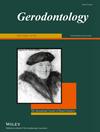Electrolysed oxidising water as a multi-purpose biocide in dental healthcare—A scoping review
Abstract
Objectives
The objective of this scoping review was to map evidence of electrolysed oxidising water (EOW) as a biocide for dental applications of relevance to older people and identify research gaps.
Background
EOW is an emerging, “green,” and cost-effective biocide. There are no reviews on the landscape of EOW research as either an antiseptic or disinfectant in dental healthcare or its suitability for the oral healthcare of older people.
Materials and Methods
The review follows the PRISMA Extension for Scoping Reviews (PRISMA-ScR) guidelines. Database searches (Google Scholar, PubMed, Web of Science, Ovid, Scopus and Science Direct) were undertaken using MESH terms and Boolean operators with no date restrictions, to identify full-text, original reports published in English-language peer-reviewed journals.
Results
The search yielded 114 papers that met the inclusion/exclusion criteria. Dental applications of EOW include its use as an endodontic irrigant (39%); mouth rinse/surgical irrigant (21%); disinfectant for dental unit water lines (19%) and dental biomaterials (17%); and for antimicrobial efficacy, effects on oral tissues and on dental material properties. Most studies (83%) evaluated a single EOW formulation (acidic, moderately acidic or neutral) that was either generated at ‘point-of-use’ (POU; 72%), bottled (‘ready-to-use’, RTU; 24%) or from unspecified (3%) sources. Six reports evaluated storage-related parameters and 25 evaluated clinical applications; 89 were in vitro studies and one investigated the cost-effectiveness of POU EOW.
Conclusions
Neutral-pH, EOW is effective as an antimicrobial agent without deleterious effects on oral tissues. However, research on the impact of storage conditions, anti-Candida biofilm efficacy and mechanism of action against yeasts, long-term effects on denture materials and cost-effectiveness is required to establish the suitability of EOW as a multipurpose biocide for dental healthcare, including infection-control requirements relating to older people.


 求助内容:
求助内容: 应助结果提醒方式:
应助结果提醒方式:


